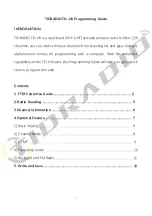
Exalt Communications Inc.
EX-2.4i Installation and Maintenance Manual
Page 5
MAN-002400, Revision 001
2005-12-01
Section 2 – Before Installation
2.0 Link Engineering and Site Planning
Any terrestrial wireless link should be designed prior to purchase and installation. Generally,
professional wireless engineering personnel are engaged to determine the viability and
requirements for a well-engineered link that will meet the user’s needs for reliability.
The reader is referred to the document “Exalt Communications: Guidance for Engineering and
Site Planning of Terrestrial Wireless Links.” This document describes all of the pre-planning and
engineering that is required to determine the following parameters:
•
Antenna type/gain at each end of the link
•
Antenna mounting height/location for proper path clearance
•
Antenna polarization orientation
•
RF Cabling type, length, connectors, route and mounting
•
Antenna system grounding
•
Lightning arrestor type(s), location(s) and grounding
•
Radio mounting location and mechanisms
•
Radio output power setting
•
Radio grounding
•
Anticipated Received Signal Level (RSL) at each end
With respect to radio path and site planning, the EX-2.4i is generally identical to any other
microwave terrestrial wireless system. Engineering of these systems may not require significant
specific knowledge about the EX-2.4i itself. The most important parameters being:
•
RF specifications (output power, threshold, occupied bandwidth, carrier-to-interference
tolerance)
•
Regulatory limitations on output power setting and antenna type/gain
2.1 Laboratory Back-to-Back Test
It is strongly advised to perform a back-to-back test, in a controlled environment, prior to
installation. This will allow you to perform several tasks which can be much more difficult to
perform once the radio link endpoints are distant from one another. Most importantly, a back-to-
back test will provide confidence that the radio link is operational and configured properly
prior
to installation, so that if troubleshooting is necessary, the radio hardware and configuration
settings are eliminated from the troubleshooting process.
•
Confirm that the radio system is generally operational
o
Radios power-up with planned power and wiring solutions
















































